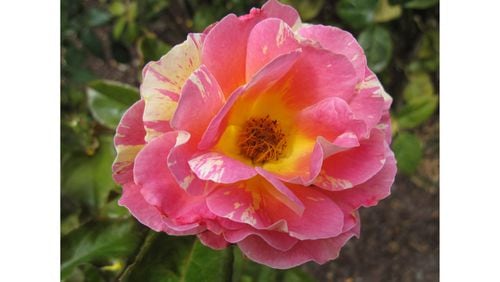Q: I have tried to root roses several different times by different techniques: in dirt, in water, using new growth, and with rooting powder. I’ve had no luck. What am I doing wrong? Michael Luke, email
A: The three mistakes I see most often when rooting roses are cuttings that are too long, failure to keep humidity high around the cuttings, and using the wrong rooting media. Cuttings of 4 to 6 inches should be taken in early summer when they’re stiff enough to break, not bend, in your hands. A couple of leaves should remain on the green end of the cutting. Dust the cut surface with a rooting hormone (Rootone). Use a plastic bag over each cutting to keep humidity high. The best rooting media is peat moss mixed 1:1 with perlite. Once you find the right combination of skills, you’ll have a lifetime of enjoyment.
Q: My parents have centipede grass. Only a few lawn services handle centipede, and we were extremely unhappy with the one we hired. We want to do it on our own. What is the right preemergent and fertilizer? Any suggestions on managing centipede? David Doster, Norcross
A: Stop! You can harm your centipede grass by applying preemergent. This grass spreads by stolons (runners) that travel across the top of the soil. Stolons put down roots at intervals. Most preemergents work by inhibiting root growth, so unless your grass is thick, preemergents are the wrong idea. Centipede care is the opposite of Bermuda grass or fescue. It thrives under less care, not more. That’s why companies hesitate to take on a centipede lawn. A mowing height of less than 2 inches is best for centipede grass. Centipede fertilizer (15-15-15 or 13-13-13) is applied only twice per year. I have lawn care calendars for all grasses at bit.ly/lawncalendars and an excellent guide to centipede care specifically at bit.ly/GAcenticare.
Q: I live in North Georgia. I would like some milkweed to grow for the caterpillars. I have done this many times in the past, and watching them evolve into monarch butterflies with my granddaughters is amazing. Can you advise me what kind of plants are best for my area? Sue Sims, email
A: The Environmental Education Alliance (eealliance.org) sponsors Monarchs Across Georgia, and they have lots of resources online (bit.ly/GAmonarchs). Their Selecting Plants for Pollinators (bit.ly/GAplantspoll) is awesome. And if you want to buy plants, I have several sources at bit.ly/GAnatives.
Email Walter at georgiagardener@yahoo.com. Listen to his occasional garden comments on “Green and Growing with Ashley Frasca” Saturday mornings on 95.5 WSB. Visit his website, walterreeves.com, or join his Facebook page at bit.ly/georgiagardener for his latest tips.
About the Author






